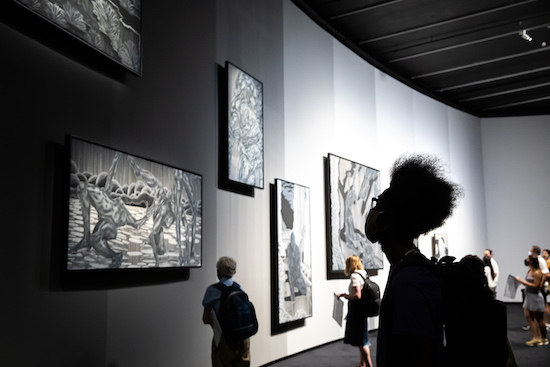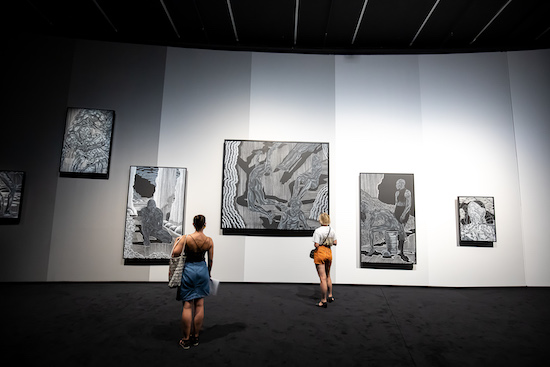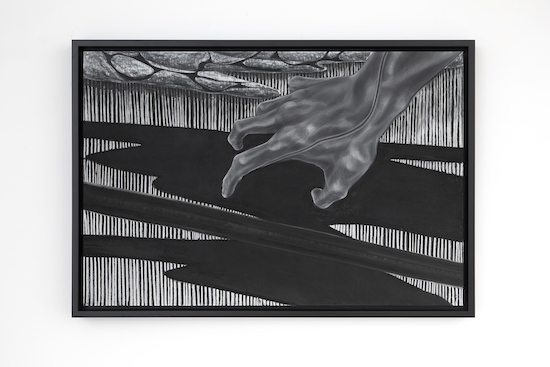Toyin Ojih Odutola, A Forbidden Impulse from A Countervailing Theory (2019) © Toyin Ojih Odutola. Courtesy of the artist and Jack Shainman Gallery, New York
Toyin Ojih Odutola’s A Countervailing Theory is a painting exhibition, but it feels like a world you can step into, inhabit and explore. On entering the Barbican Curve Gallery you submit to an alternative universe where society’s norms are countered and tilted. To countervail a system or ideology is to create an opposite or simply a differing equivalent, it’s commonly thought that ideas thrown up by this opposition benefits both sides.
Black and white drawn figures ranging from huge to life-size tell the story of a forgotten Nigerian society in which same sex relationships are conventional and women hold the strings of political power. Within that world, the exhibition spins a love story in which a man and a woman fall in love and try and have to deal with the blow back from this society as a result. Through a literal and metaphorical mining, she subtly switches up conventions, as you move through the chronologically ordered narrative exhibition accompanied by a sound installation from Peter Adjaye (brother of architect David Adjaye).
It is difficult to convey how visually stunning these works are for their technical skill alone but there is so much more going on here than aesthetic beauty. Through this deep, sweeping exhibition Ojih Odutola makes us consider the world around us and question the status quo while bathing in the sheer brilliance of her work.
Your show was postponed by the pandemic and then landed in a totally different context, did that change how you thought and felt about it?
Once the pandemic hit the US, compounded with the global resurgence of the Black Lives Matter movement, I was reticent about whether the world needed this sort of culture. So much death, pain, anxiety and rapid change permeated everything – and many of the ideas explored in this work are quite dark. I was uncertain whether it was responsible to show A Countervailing Theory (ACT) for many months. I had yet to experience the exhibition, and was working on another series while installing and planning the exhibition via multiple video conferences.
You have to understand, we had no idea whether the show would ever be shown to the public. Much of what informed my decisions in the proceeding months, despite not seeing it, was based on intuition. I had to gather myself repeatedly and believe that whatever I created and planned would help in some way towards a collective healing and ask the pertinent questions needed right now.
When I finally got to see the show this month after quarantine, it was incredibly surreal and overwhelming. It’s hard to describe the gamut of emotions that flooded me. I’m grateful all that we have worked hard to maintain stayed true in the end and is felt by whoever comes to visit the space.

Toyin Ojih Odutola, A Countervailing Theory, 2020. Installation view, The Curve, Barbican, 11 August
2020 – 24 January 2021. © Toyin Ojih Odutola. Courtesy of the artist and Jack Shainman Gallery, New York. Photo: Tim Whitby / Getty Images
What makes you want to create bodies of work with a narrative?
Kathleen Collins once said, when you are subjugated, you have to quell your propensity towards creating myths of saints or demons, because you think there is no room for ambiguity, for nuance, for opacity. You are always fighting against a projection where the black figure in a pictorial arena cannot hold its own without addressing that subjugation – as if, that is the only story to be found. This redacts agency and prevents the image from being anything other than fetish for the colonialist gaze.
I liken the saint/demon paradigm to the problem of the posing black beauty in fine art. A genre, it seems, that is suspiciously popular right now. I myself was embroiled in it for three years, but noticed an uncomfortable convenience to how this image was being consumed. Although the series I created between 2016 and 2018 was also an immersive narrative, I was insecure about the construction of the images and fell prey to Eurocentric pictorial tropes. With ACT, I knew I had to disassociate myself from the belief that representation alone is the answer to emancipation, and instead see its true role: mainstream legibility and legitimacy. Having the narrative take precedence liberated my thinking from that static endpoint into more interesting questions: from “who is this figure addressing?” to “where is this picture leading?"
Narrative offers freedom of movement regardless of who might be there to witness. It disrupts an immobilising pose and complicates beauty. It makes the picture less convenient, less palatable, providing infinite possibilities to create because the figures in my stories exist and thrive beyond my ideas and the marks I’ve made into their own world. Representation is never enough, I want my pictures to be autonomous.
When a picture is a part of a larger story, and not individualized – when the image you experience transcends the flattening of prescribed notions around how a black figure is meant to be shown and interact with viewership – you see how dangerous a lack of narrative can be. To test this, ask yourself: What are these characters doing? What is happening here? And if you as a viewer cannot answer beyond a one-note sentence, there’s your evidence. Story liberates the posing black figure from the simplicity of the gaze and how insidious and unrelenting that framework can be. My aim is to get to a place more complex.

Toyin Ojih Odutola, To See and To Know; Future Lovers from A Countervailing Theory (2019) © Toyin Ojih Odutola. Courtesy of the artist and Jack Shainman Gallery, New York
Did you create any of the work before you began to create the narrative – it feels to me like it borders on a kind of science-fiction ‘world-building’?
I spent roughly eight months on research: reading geological surveys; sorting through various academic publications; collecting images of the Jos Plateau region; and playing with concepts of countervailing. Once I could build a foundation for the narrative, I felt confident enough to proceed with my drawings, spending the remaining months of 2019 testing out the visual methods I would eventually use within the monochromatic palette. There was a great deal of “world building” as you say, but it was applied in a way I feel is best described by the writer, M. John Harrison:
“Worldbuilding is dull. Worldbuilding literalises the urge to invent. Worldbuilding gives an unnecessary permission for acts of writing (indeed, for acts of reading). Worldbuilding numbs the reader’s ability to fulfil their part of the bargain, because it believes that it has to do everything around here if anything is going to get done.”
Thus, I wanted to create a world which could invite active participation. I didn’t want to set up a place that was fully defined, where the gaps are so air-tight with details you can’t engage with what you’re experiencing. I’m not conducting a lecture, I’m setting up a structure for anyone who is willing to take the time to build upon and expand. It’s their choice. I’ve done my work.
The impact of these amazing images in the dark Curve Gallery space is incredibly strong. Did you choose the black and white palette of the show to fit the space or was there another reason?
I created this body of work with The Curve gallery in mind. From the moment I first visited the space, I felt the potential for a story to “unfold” in real time. Each visitor has the agency to move through the story at their own pace, revealing itself slowly through the span of the ninety meter expanse – like a hand scroll.
I knew immediately, before even conducting the research, that I wanted to work within a monochromatic palette. The materials were still being tested early on, but pastel and charcoal were going to be my tools. The challenge was to render these pictures in a way that was unfamiliar to me.
I wasn’t thinking about how the work would be received. You have to close off all expectation early on to take the risk. Colour is very powerful and, if mishandled, can be distracting. I wanted to establish a formalist language which the world could proliferate from; one where you could get lost in and forget about the palette and pay attention to the marks, linguistically.
The history of marks in every picture you encounter is layered with meaning – they are textual. This is why the concept of “countervailing” was so revelatory when I arrived at it. It meant not only usurping the preconceived notions of an audience, but my own as the creator of this work. It was challenging at times to solve some of the pictorial compositions through what some might see as a limited or restricted palette; but having those parameters was incredibly freeing and useful for me in the studio. It provided opportunities to expand my visual language and engage with the materials I was using in surprising ways. This also helped inform how I would present the work in the space, with the gradated stripes along the wall extending from the visual palette of my drawings into the space.
The music in the exhibition is wonderful. It immediately envelops you on entering the exhibition and carries you through the story it tells. Was that your intention and if so could you tell me a bit about that?
When I presented my proposal for ACT to the Barbican Centre in February 2019, I had included the possibility of a soundtrack to accompany the exhibition. Initially, I thought I might create something minimal in tone, which could aid in immersing a visitor into this world I was creating. After a couple months of trials, I realised I needed to bring in a sound engineer with more experience if I wanted to create this intended effect.
I had been listening to a variety of music while creating ACT that tended towards the pulsating and rhythmic, so I wanted to have a sound which could reflect a multi-sensorial experience. My dear friend, Erin J. Gilbert, suggested Peter Adjaye’s work. After listening to some of his compositions made with his brother, David, for the project Music for Architecture, I knew I’d found someone who might help me establish the potential sound needed to create the atmosphere of this world.
I sent Peter a list of music I’d been listening to in order to help him register the framework I wanted to work within, as well as sharing some of my notes on the story. From there, I left him to it. The final soundscape he created is what you are experiencing as you move through the space. It is the perfect accompaniment to the story, following you through in a beautiful, measured way.

Toyin Ojih Odutola, A Countervailing Theory, 2020. Installation view, The Curve, Barbican, 11 August 2020 – 24 January 2021 © Toyin Ojih Odutola. Courtesy of the artist and Jack Shainman Gallery, New York. Photo: Tim Whitby / Getty Images
The concept of A Countervailing Theory feels very important at the moment – being able to have one and being able to share one – where did the idea come (from)?
There’s something which often comes up when I read the responses to the show thus far that slightly troubles me: that I’ve somehow created a vision of utopia in ancient West Africa. This was never the intention, never the focus. The reason it’s called a “theory” is to challenge notions of oppression and my own implicit biases about power.
Showing ACT at the Barbican Centre, in London, was important. This is the same city where – not too far from the Barbican – the British Museum holds ‘The Benin Bronzes’: 16th century bronze caste plates that found their way to the institution via dubious means. The colonialist history that colours cultural institutions in the UK was present in my mind as I created the works for the show. Also, when I became cognizant of the fact that I was the first woman artist of African descent and heritage to show in The Curve gallery, I knew I had to create a work to activate this much needed conversation around oppression, the legacy of colonialism and looting of an entire continent’s wealth and artefacts.
The story you experience in ACT is not fair, it’s not utopic, it’s a mining – it’s a means to bring up questions that are often buried, ignored, and lied about to avoid a nation’s discomfort around its global power. It is also a story for young people to see that there is more to image-making and world-building than they might realize.
There is a key moment in the narrative of the story where the two main characters share their stories, finally seeing one another, and an understanding comes to the fore. It usurps the striated world which is imposed upon them and from there they lay the groundwork to build a new world, but they do not live to see it come to fruition.
You may think because of how a system regards you and people like you, your agency and power is inconsequential, but it is not. Utopias are traps. The world we are trying to build is always in flux, always subject to questioning, rigour, and collective engagement in order to change. The world you see on the walls of The Curve gallery is rather similar to ours, where those who believe they have a right to what they have will do anything in their power to perpetuate that right, even if it is a lie. I’m simply asking: what do we do with this knowledge?
Toyin Ojih Odutola, A Countervailing Theory, is at the Barbican Curve Gallery until 24 January 2021


